Yang Yang
Department of Biostatistics and Bioinformatics, Duke University, Durham, USA
Fast SAM2 with Text-Driven Token Pruning
Dec 24, 2025Abstract:Segment Anything Model 2 (SAM2), a vision foundation model has significantly advanced in prompt-driven video object segmentation, yet their practical deployment remains limited by the high computational and memory cost of processing dense visual tokens across time. The SAM2 pipelines typically propagate all visual tokens produced by the image encoder through downstream temporal reasoning modules, regardless of their relevance to the target object, resulting in reduced scalability due to quadratic memory attention overhead. In this work, we introduce a text-guided token pruning framework that improves inference efficiency by selectively reducing token density prior to temporal propagation, without modifying the underlying segmentation architecture. Operating after visual encoding and before memory based propagation, our method ranks tokens using a lightweight routing mechanism that integrates local visual context, semantic relevance derived from object-centric textual descriptions (either user-provided or automatically generated), and uncertainty cues that help preserve ambiguous or boundary critical regions. By retaining only the most informative tokens for downstream processing, the proposed approach reduces redundant computation while maintaining segmentation fidelity. Extensive experiments across multiple challenging video segmentation benchmarks demonstrate that post-encoder token pruning provides a practical and effective pathway to efficient, prompt-aware video segmentation, achieving up to 42.50 percent faster inference and 37.41 percent lower GPU memory usage compared to the unpruned baseline SAM2, while preserving competitive J and F performance. These results highlight the potential of early token selection to improve the scalability of transformer-based video segmentation systems for real-time and resource-constrained applications.
From Visual Perception to Deep Empathy: An Automated Assessment Framework for House-Tree-Person Drawings Using Multimodal LLMs and Multi-Agent Collaboration
Dec 23, 2025Abstract:Background: The House-Tree-Person (HTP) drawing test, introduced by John Buck in 1948, remains a widely used projective technique in clinical psychology. However, it has long faced challenges such as heterogeneous scoring standards, reliance on examiners subjective experience, and a lack of a unified quantitative coding system. Results: Quantitative experiments showed that the mean semantic similarity between Multimodal Large Language Model (MLLM) interpretations and human expert interpretations was approximately 0.75 (standard deviation about 0.05). In structurally oriented expert data sets, this similarity rose to 0.85, indicating expert-level baseline comprehension. Qualitative analyses demonstrated that the multi-agent system, by integrating social-psychological perspectives and destigmatizing narratives, effectively corrected visual hallucinations and produced psychological reports with high ecological validity and internal coherence. Conclusions: The findings confirm the potential of multimodal large models as standardized tools for projective assessment. The proposed multi-agent framework, by dividing roles, decouples feature recognition from psychological inference and offers a new paradigm for digital mental-health services. Keywords: House-Tree-Person test; multimodal large language model; multi-agent collaboration; cosine similarity; computational psychology; artificial intelligence
Seedance 1.5 pro: A Native Audio-Visual Joint Generation Foundation Model
Dec 23, 2025Abstract:Recent strides in video generation have paved the way for unified audio-visual generation. In this work, we present Seedance 1.5 pro, a foundational model engineered specifically for native, joint audio-video generation. Leveraging a dual-branch Diffusion Transformer architecture, the model integrates a cross-modal joint module with a specialized multi-stage data pipeline, achieving exceptional audio-visual synchronization and superior generation quality. To ensure practical utility, we implement meticulous post-training optimizations, including Supervised Fine-Tuning (SFT) on high-quality datasets and Reinforcement Learning from Human Feedback (RLHF) with multi-dimensional reward models. Furthermore, we introduce an acceleration framework that boosts inference speed by over 10X. Seedance 1.5 pro distinguishes itself through precise multilingual and dialect lip-syncing, dynamic cinematic camera control, and enhanced narrative coherence, positioning it as a robust engine for professional-grade content creation. Seedance 1.5 pro is now accessible on Volcano Engine at https://console.volcengine.com/ark/region:ark+cn-beijing/experience/vision?type=GenVideo.
Understanding Chain-of-Thought in Large Language Models via Topological Data Analysis
Dec 22, 2025



Abstract:With the development of large language models (LLMs), particularly with the introduction of the long reasoning chain technique, the reasoning ability of LLMs in complex problem-solving has been significantly enhanced. While acknowledging the power of long reasoning chains, we cannot help but wonder: Why do different reasoning chains perform differently in reasoning? What components of the reasoning chains play a key role? Existing studies mainly focus on evaluating reasoning chains from a functional perspective, with little attention paid to their structural mechanisms. To address this gap, this work is the first to analyze and evaluate the quality of the reasoning chain from a structural perspective. We apply persistent homology from Topological Data Analysis (TDA) to map reasoning steps into semantic space, extract topological features, and analyze structural changes. These changes reveal semantic coherence, logical redundancy, and identify logical breaks and gaps. By calculating homology groups, we assess connectivity and redundancy at various scales, using barcode and persistence diagrams to quantify stability and consistency. Our results show that the topological structural complexity of reasoning chains correlates positively with accuracy. More complex chains identify correct answers sooner, while successful reasoning exhibits simpler topologies, reducing redundancy and cycles, enhancing efficiency and interpretability. This work provides a new perspective on reasoning chain quality assessment and offers guidance for future optimization.
Interaction-via-Actions: Cattle Interaction Detection with Joint Learning of Action-Interaction Latent Space
Dec 18, 2025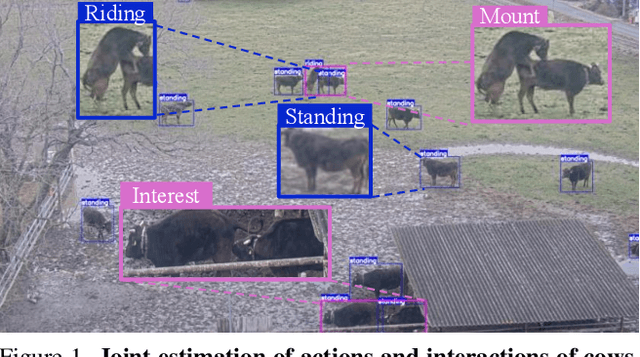
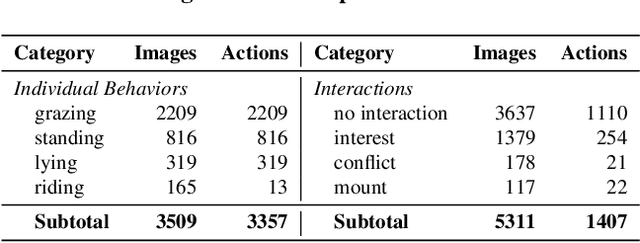
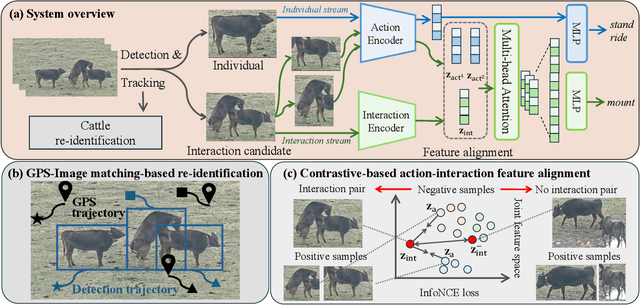

Abstract:This paper introduces a method and application for automatically detecting behavioral interactions between grazing cattle from a single image, which is essential for smart livestock management in the cattle industry, such as for detecting estrus. Although interaction detection for humans has been actively studied, a non-trivial challenge lies in cattle interaction detection, specifically the lack of a comprehensive behavioral dataset that includes interactions, as the interactions of grazing cattle are rare events. We, therefore, propose CattleAct, a data-efficient method for interaction detection by decomposing interactions into the combinations of actions by individual cattle. Specifically, we first learn an action latent space from a large-scale cattle action dataset. Then, we embed rare interactions via the fine-tuning of the pre-trained latent space using contrastive learning, thereby constructing a unified latent space of actions and interactions. On top of the proposed method, we develop a practical working system integrating video and GPS inputs. Experiments on a commercial-scale pasture demonstrate the accurate interaction detection achieved by our method compared to the baselines. Our implementation is available at https://github.com/rakawanegan/CattleAct.
Toward expert-level motivational interviewing for health behavior improvement with LLMs
Dec 17, 2025Abstract:Background: Motivational interviewing (MI) is an effective counseling approach for promoting health behavior change, but its impact is constrained by the need for highly trained human counselors. Objective: This study aimed to explore a scalable alternative by developing and evaluating Large Language Models for Motivational Interviewing (MI-LLMs). Methods: We first curated five Chinese psychological counseling corpora and, using GPT-4 with an MI-informed prompt, transcribed multi-turn dialogues from the two highest-quality datasets (CPsyCounD and PsyDTCorpus) into 2,040 MI-style counseling conversations, of which 2,000 were used for training and 40 for testing. Three Chinese-capable open-source LLMs (Baichuan2-7B-Chat, ChatGLM-4-9B-Chat and Llama-3-8B-Chinese-Chat-v2) were fine-tuned on this corpus and were named as MI-LLMs. We evaluated MI-LLMs using round-based automatic metrics and expert manual coding with the Motivational Interviewing Treatment Integrity (MITI) Coding Manual 4.2.1. Results: Across all three models, fine-tuning substantially improved BLEU-4 and ROUGE scores compared with the base models, and manual coding showed that MI-LLMs achieved technical and relational global scores, and MI-adherent ratios that approached those of real MI dialogues, although complex reflections and reflection-to-question ratios remained less frequent. Conclusions: These findings provide initial evidence that MI-oriented fine-tuning can endow general-purpose LLMs with core MI-consistent counseling behaviors, suggesting a scalable pathway toward AI-assisted health behavior change support while underscoring the need for further work on data scale, complex MI skills and real-world intervention trials.
GaussianPlant: Structure-aligned Gaussian Splatting for 3D Reconstruction of Plants
Dec 16, 2025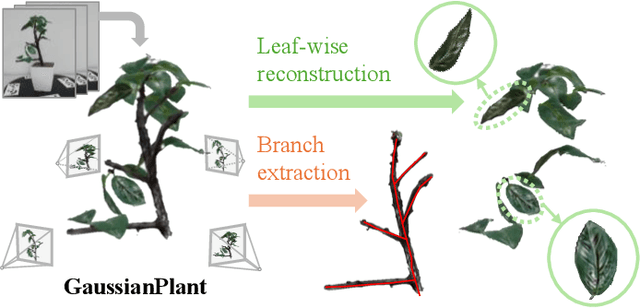

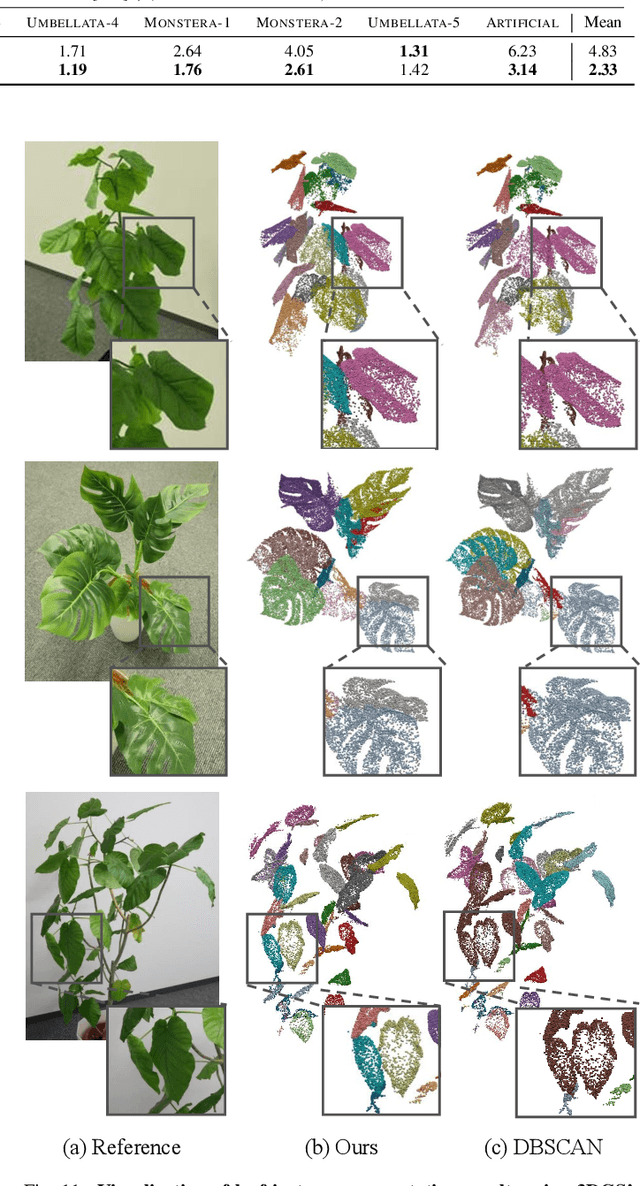

Abstract:We present a method for jointly recovering the appearance and internal structure of botanical plants from multi-view images based on 3D Gaussian Splatting (3DGS). While 3DGS exhibits robust reconstruction of scene appearance for novel-view synthesis, it lacks structural representations underlying those appearances (e.g., branching patterns of plants), which limits its applicability to tasks such as plant phenotyping. To achieve both high-fidelity appearance and structural reconstruction, we introduce GaussianPlant, a hierarchical 3DGS representation, which disentangles structure and appearance. Specifically, we employ structure primitives (StPs) to explicitly represent branch and leaf geometry, and appearance primitives (ApPs) to the plants' appearance using 3D Gaussians. StPs represent a simplified structure of the plant, i.e., modeling branches as cylinders and leaves as disks. To accurately distinguish the branches and leaves, StP's attributes (i.e., branches or leaves) are optimized in a self-organized manner. ApPs are bound to each StP to represent the appearance of branches or leaves as in conventional 3DGS. StPs and ApPs are jointly optimized using a re-rendering loss on the input multi-view images, as well as the gradient flow from ApP to StP using the binding correspondence information. We conduct experiments to qualitatively evaluate the reconstruction accuracy of both appearance and structure, as well as real-world experiments to qualitatively validate the practical performance. Experiments show that the GaussianPlant achieves both high-fidelity appearance reconstruction via ApPs and accurate structural reconstruction via StPs, enabling the extraction of branch structure and leaf instances.
Calibrating Uncertainty for Zero-Shot Adversarial CLIP
Dec 15, 2025Abstract:CLIP delivers strong zero-shot classification but remains highly vulnerable to adversarial attacks. Previous work of adversarial fine-tuning largely focuses on matching the predicted logits between clean and adversarial examples, which overlooks uncertainty calibration and may degrade the zero-shot generalization. A common expectation in reliable uncertainty estimation is that predictive uncertainty should increase as inputs become more difficult or shift away from the training distribution. However, we frequently observe the opposite in the adversarial setting: perturbations not only degrade accuracy but also suppress uncertainty, leading to severe miscalibration and unreliable over-confidence. This overlooked phenomenon highlights a critical reliability gap beyond robustness. To bridge this gap, we propose a novel adversarial fine-tuning objective for CLIP considering both prediction accuracy and uncertainty alignments. By reparameterizing the output of CLIP as the concentration parameter of a Dirichlet distribution, we propose a unified representation that captures relative semantic structure and the magnitude of predictive confidence. Our objective aligns these distributions holistically under perturbations, moving beyond single-logit anchoring and restoring calibrated uncertainty. Experiments on multiple zero-shot classification benchmarks demonstrate that our approach effectively restores calibrated uncertainty and achieves competitive adversarial robustness while maintaining clean accuracy.
Harmonizing Generalization and Specialization: Uncertainty-Informed Collaborative Learning for Semi-supervised Medical Image Segmentation
Dec 15, 2025Abstract:Vision foundation models have demonstrated strong generalization in medical image segmentation by leveraging large-scale, heterogeneous pretraining. However, they often struggle to generalize to specialized clinical tasks under limited annotations or rare pathological variations, due to a mismatch between general priors and task-specific requirements. To address this, we propose Uncertainty-informed Collaborative Learning (UnCoL), a dual-teacher framework that harmonizes generalization and specialization in semi-supervised medical image segmentation. Specifically, UnCoL distills both visual and semantic representations from a frozen foundation model to transfer general knowledge, while concurrently maintaining a progressively adapting teacher to capture fine-grained and task-specific representations. To balance guidance from both teachers, pseudo-label learning in UnCoL is adaptively regulated by predictive uncertainty, which selectively suppresses unreliable supervision and stabilizes learning in ambiguous regions. Experiments on diverse 2D and 3D segmentation benchmarks show that UnCoL consistently outperforms state-of-the-art semi-supervised methods and foundation model baselines. Moreover, our model delivers near fully supervised performance with markedly reduced annotation requirements.
ADHint: Adaptive Hints with Difficulty Priors for Reinforcement Learning
Dec 15, 2025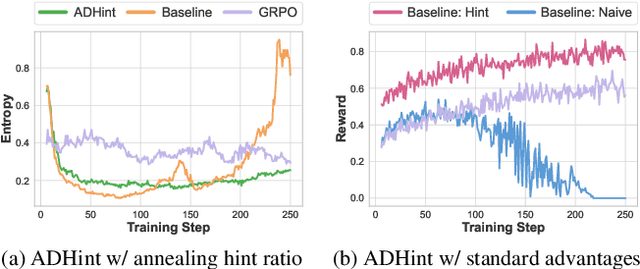
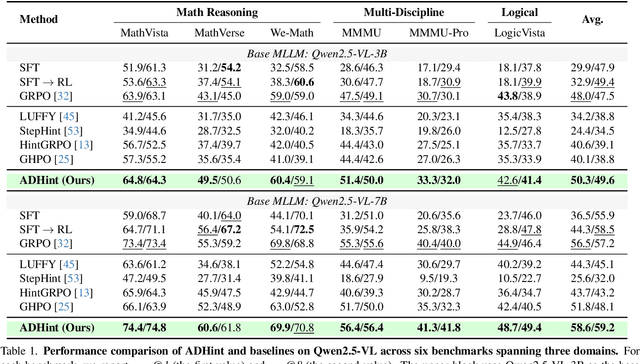
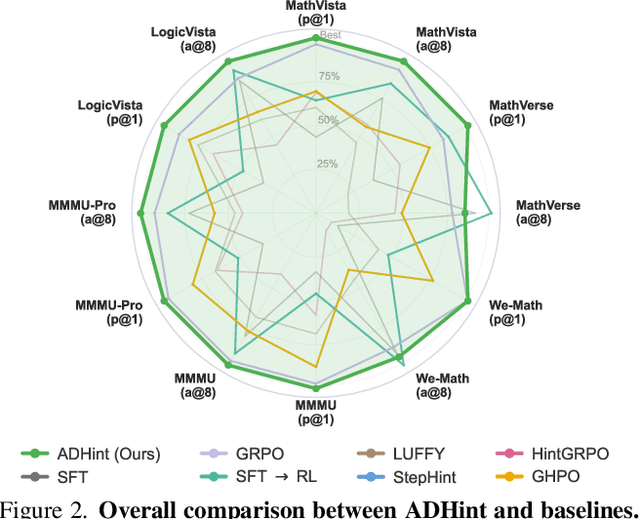
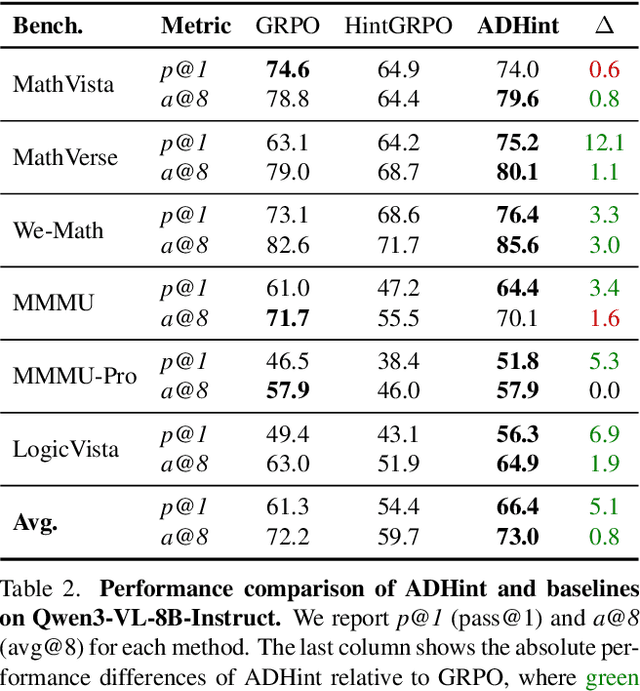
Abstract:To combine the advantages of Supervised Fine-Tuning (SFT) and Reinforcement Learning (RL), recent methods have integrated ''hints'' into post-training, which are prefix segments of complete reasoning trajectories, aiming for powerful knowledge expansion and reasoning generalization. However, existing hint-based RL methods typically ignore difficulty when scheduling hint ratios and estimating relative advantages, leading to unstable learning and excessive imitation of off-policy hints. In this work, we propose ADHint, which treats difficulty as a key factor in both hint-ratio schedule and relative-advantage estimation to achieve a better trade-off between exploration and imitation. Specifically, we propose Adaptive Hint with Sample Difficulty Prior, which evaluates each sample's difficulty under the policy model and accordingly schedules an appropriate hint ratio to guide its rollouts. We also introduce Consistency-based Gradient Modulation and Selective Masking for Hint Preservation to modulate token-level gradients within hints, preventing biased and destructive updates. Additionally, we propose Advantage Estimation with Rollout Difficulty Posterior, which leverages the relative difficulty of rollouts with and without hints to estimate their respective advantages, thereby achieving more balanced updates. Extensive experiments across diverse modalities, model scales, and domains demonstrate that ADHint delivers superior reasoning ability and out-of-distribution generalization, consistently surpassing existing methods in both pass@1 and avg@8. Our code and dataset will be made publicly available upon paper acceptance.
 Add to Chrome
Add to Chrome Add to Firefox
Add to Firefox Add to Edge
Add to Edge